
Zapek's stuff
The life of a programmer
I co-developed Voyager together with Oliver Wagner who started it in 1995. This is a fully featured browser for AmigaOS supporting plenty of web “standards”. There was also a version for an embedded system (CaOS) and it was also bundled with MorphOS . It runs on 68k, coldfire and PPC.
Here are some of its features:
- content negociation
- persistent connections (keep alive)
- cache control (expirations, if-modified-since, etc..)
- authentication
- language tags
- useragent spoofing for broken websites
- anonymous and normal logins
- persistent connections
- advanced LIST (aka ls -l) parsing
- EPLF support
- can send simple mails from webpage links
- HTML 3.2, supported tags follows
- STYLE (hidden, searched for JS)
- SCRIPT (Javascript)
- META (http-equiv (refresh, pragma (no-cache), content-type) meta values)
- LINK (ignored, not important)
- BODY, BGCOLOR, TEXT, LINK, ALINK, VLINK, BACKGROUND
- H1, H2, H3, H4, H5, H6
- ADDRESS (no special action)
- P (left, right, center, middle+)
- DL, DT (not handled)
- DIR (ignored, useless)
- MENU (ignored, useless)
- LISTING (not handled, obsolete)
- PLAINTEXT (not handled, obsolete)
- BLCKQUOTE (ignored, useless)
- FORM (action, target, method, enctype)
- HR (width, size, noshade, color)
- TABLE (bgcolor+, background+, cellpadding, cellspacing, border, width, height+, bordercolordark+, bordercolorlight+, bordercolor+, align)
- TR (bgcolor+, background+, valign, align)
- TD/TH (bgcolor+, background+, width, height, rowspan, colspan, valign, align, nowrap)
- SUB (ignored)
- SUP (ignored)
- INPUT (type (text, password, checkbox, button+, radio, submit, image, reset, file, hidden), name, value, checked, size, maxlength, src, align)
- SELECT (size, multiple, disabled)
- TEXTAREA (disabled, rows, cols, readonly+)
- A (href, title, target+, accesskey+, rel and rev are useless)
- IMG (src, alt, align, width, height, hspace, vspace, border, ismap, usemap, lowsrc+)
- APPLET (not supported, no JVM)
- FONT (color, size, face+)
- BR (clear=left/right/all)
- AREA (shape, href, target, coords, accesskey+)
- EMBED+ (type, src, width, height, hspace, vspace, border, align)
- up to 168-bit keys
- certificates handling
Javascript 1.3/ECMA-Script
- VFlash: flash player, flash 3 and some flash 4 stuff
- VPDF: PDF viewer by Emmanuel Lesueur
- variable sized memory cache
- variable sized disk cache
- automatic cleanup
- no index, always consistent
Image decoder
- fast inline decoding of pictures
- images are cached as long as there’s free memory
- GIF (with animated and progressive support)
- PNG (with true alpha channel support)
HTML Editor
- internal web page editing with HTML tag highlighting
You can download the GPL release of Voyager .


University of Washington Interactive Data Lab
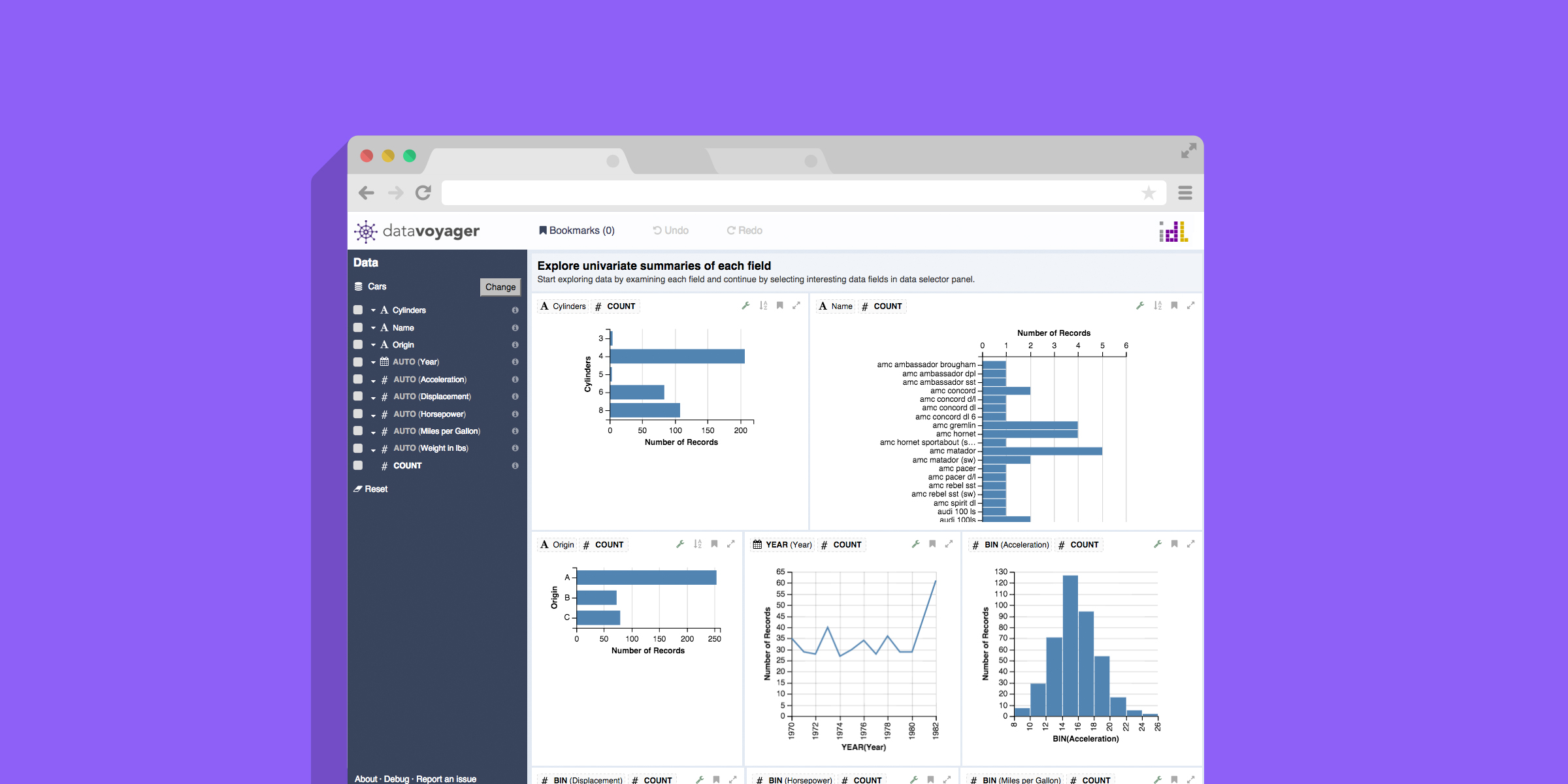
More work like this at Bocoup

HMS LINCS Breast Cancer Browser
Lorem ipsum dolor sit amet, consectetur adipiscing elit, sed do eiusmod tempor incididunt ut labore et dolore magna aliqua. Ut enim ad minim veniam, quis nostrud exercitation ullamco laboris nisi ut aliquip ex ea commodo consequat. Duis aute irure dolor in reprehenderit in voluptate velit esse cillum dolore eu fugiat nulla pariatur.
Block quote
Ordered list
Unordered list
Superscript
Voyager 101: Introduction to Voyager

Lumafield Voyager is a powerful AI-enabled, cloud-based software platform for viewing, analyzing, and sharing 3D scans and industrial CT scans. In this video, Lumafield Co-Founder and Head of Product Andreas Bastian introduces Voyager and its AI co-pilot Atlas .
Voyager and Atlas make it easy to inspect parts, compare parts to their original CAD models, take dimensions, and share data with collaborators. Atlas also offers immediate access to the world's manufacturing knowledge by answering engineering questions in plain language.
Start using Voyager for free .
Learn how to get started with Lumafield Voyager, an AI-enabled, cloud-based platform for viewing, analyzing, and sharing 3D scans and industrial CT scans.


Migration to Godot 4, restructuring (editor plugins!), and plans for beta and beyond…
A lot is happening if you follow our development at GitHub! As always, I encourage you to visit our discussion forum and try the newly updated web-based Planetarium . And, please do consider getting involved in our development! I, Voyager is open-source and I’d like to see it become a community effort. Our About has more information for contributors.
We’ve migrated to Godot 4!
I, Voyager continues to grow and improve in tandem with the open-source Godot Engine . In November/December of 2017, the Planetarium was a set of orbiting TestCubes running in Godot 2, which only barely supported 3D. From 2018 to early 2023, the project evolved into an open-source solar system simulation and planetarium using Godot 3 — all the while Godot was evolving into a much more sophisticated development platform and 3D rendering engine. And now, after a wee bit of effort from yours truly, we’ve moved on to Godot 4. As always, this kind of update involves a few steps forward and a few back, but sets us up for the future as Godot continues to evolve and improve.
Our web-based Planetarium is now v0.0.18 running on Godot Engine 4.2.1. Please try it and give feedback! Note that Godot 4.2.1 is still a little rough for deployment of HTML5 applications (as noted above, a few steps back). There are presently issues with lighting and our large solar system scale. You may notice that terminators are way too sharp. On the other hand, Godot 4 handles large numbers of meshes much more efficiently. You can now view our 70,000+ asteroid orbital tracks simultaneously even in the web browser app!
I, Voyager code is now a set of editor plugins
For developers, I’ve restructured our code into a set of Godot Editor plugins. This allows a whole bunch of new tricks including: 1) Our core plugin now manages its own (non-Git-tracked) assets. The plugin will check for presence and version of the ivoyager_assets directory and offer to download and update assets when appropriate. 2) Developers can now specify much I, Voyager functionality in a project-level config file . For example, this file can specify use of a different IVUnits singleton to change unit constants (e.g., METER, which sets the simulator scale).
The solar system simulation and associated GUI widgets are distributed in editor plugin ivoyager_core . This plugin requires one other editor plugin to work: ivoyager_table_importer . There is a third editor plugin, ivoyager_tree_saver , that is not used by the Planetarium but can be used for game-save functionality if you are building a game. Plugin ivoyager_core manages the non-Git-tracked assets directory ivoyager_assets (also kept in the addons directory alongside the plugins). The project structure now looks like this:
We strongly suggest developers add the plugins as Git submodules. This way, you can pull updates, checkout any commit, and (important for us!) contribute your own improvements back to us via pull requests — all from within your own project. It does take some learning to use Git submodules (if you don’t already), but this is much better than managing addons by manually moving directories.
I’ll upload these editor plugins to the Godot Asset Library with our upcoming beta release.
Beta and beyond…
With Godot 4 migration complete we’ll be moving to “beta” soon. I’m planning one more alpha release (v0.0.19) with a whole bunch of API-breaking class and function changes (of course I want to minimize these after official release!). I’m also hellbent on fixing our issue #1 lack of shadows bug (sadly, there will be no eclipse on April 8). Then I’ll release our first beta (v0.1, likely based on Godot 4.3) and work to solicit more user testing. Then, who knows? Maybe official v1.0 this summer or fall? Please let me know in our forum if you have plans or interest in using I, Voyager code in your own project! Our transition from beta to official release depends a lot on developer needs. For my own use, it’s somewhat easer to stay in beta for longer allowing breaking changes. However, if I hear from other developers, I’ll work more quickly to lock down the API and move to official release.
Please comment at our Forum!

New version 0.0.14 is out!
This is a major update for our core mechanics and content. It’s built on Godot Engine 3.5.2 , perhaps our last 3.x update before the big port to Godot 4!
Try the new Planetarium here!
Highlights:
- Saturn Rings are now shader-based (i.e., programmatically generated by the GPU).
- Models for the International Space Station and Hubble Space Telescope.
- Orbit lines for asteroids. It looks crazy if you show all ~48,000 present in the web-based Planetarium (see below) and that’s a small subset of the ~1.14 million we can add!
- Mouse-over identification of individual bodies (yes, including the ~48,000 asteroids!) and their orbit lines. This involves shader magic that will in the future be extended to almost everything: individual bands and gaps in Saturn’s Rings, individual stars, etc.
- You can now save and revisit “views” which optionally include target body, camera position, HUDs visibility & colors (e.g., asteroid points & orbit lines), and/or time state.
See the full changelog here .
Screenshots below!

Well, that’s it for core I, Voyager and the Planetarium…
In other news, the code I use to crunch raw asteroid orbit data is now public in GitHub repository ivbinary_maker . It isn’t polished (and maybe never will be) but, if you are so inclined, it will allow you to generate binary files for >1.14 million asteroids (numbered and multiopposition). I don’t know what kind of graphics card you’ll need to show those orbits! This also has the code I use to convert Saturn Ring data from Björn Jónsson (backscattered, forward-scattered, unlit, transparency & color data files) into the “1-spatial-dimension” texture used by the new the rings.shader.
Also, by the way, I’m making a game! It’s set in our Solar System. Well, I have been working on in for some years now. More on that soon…
We’ve made the Planetarium into a Progressive Web App!
Our v0.0.10-alpha release introduces the Planetarium as a Progressive Web App, or PWA. What is a PWA? You can read about it here . For the Planetarium, it means: Faster revisits due to better browser caching. The option to install the app from the web page, which will give you an app shortcut, super fast start time, and automatic updates. Easier app distribution — it’s just a url link! And much less bandwidth required from our web server.
If you’re on a desktop or laptop, give it a try! (Sorry, we’re not quite ready for mobile devices yet.) Just click the link:
https://www.ivoyager.dev/app/planetarium.html
Our underlying Godot Engine introduced PWA functionality in November. It isn’t quite yet working as it should in official Godot releases. But, as usual, Godot devs are awesome and came through for us. With a custom Godot build we have a PWA! Thanks especially to Fabio Alessandrelli ( Faless ) for making this feature happen!
About installation: It’s easy to miss if you didn’t already know about PWAs. It works a little differently on different browsers, but on Chrome you will see an ‘Install’ icon in the URL bar. (Not immediately. It appears a little while after the app has already started.) Once installed, you will have app shortcuts on your desktop and start menu (or wherever these things go in your operating system). You can now start the app in near-instant time! It works without internet. It’ll update itself quietly in the background when we post a new version. It’s also quite easy to uninstall if you need to do so.
The benefit for us is that our web server doesn’t have to serve you many MBs of data each time you use the app. This was a bit of worry for us if we ever got popular. Hopefully we are ready for a little publicity and wider use now…
Have fun using the Planetarium! And please do distribute the link above to your friends!
In other news, our Downloads page changed to Developers . We don’t have downloads any more. The Developers page is more focused and hopefully more helpful for developers who might want to contribute to the Planetarium or to build their own projects using I, Voyager.
Also, in late November early December our Forum was invaded by more than a thousand bots. But we fought them off successfully! All is well now so please do sign up on our Forum ! Due to higher security settings, however, new registrants will be asked an astronomy question. Here is the answer so you are ready…

v0.0.9-alpha is out!
Built on the new Godot 3.3. See changelog here .
Developers should be happy with modularity and extensibility improvements. Our API is not yet stable (we’re still “alpha”!) but it’s shaping up nicely. My working plan is to stay in alpha until Godot 4.0, then have a short beta phase and official release.
Do have a look at our new Planetarium ! I’ve expanded data display with closeable orbital, physical and atmosphere sections:

There are many other improvements and small bug fixes.
I, Voyager in 2021
I think we’re due for an update!
I’ve released two alpha builds since the start of the year. The Web Planetarium is shaping up nicely ( try it! ). And I feel pretty good about code architecture and how the simulator can support an “extension” game or educational project. I’ll talk about recent progress and my thoughts for future development.
First, I finally understand Godot GUI construction! Instead of attacking misbehaving Controls and Containers with lines of code, I now let them do what they want to do. Good lord! How can something so hard suddenly become so easy? So I discarded our previous Planetarium GUI (a code nightmare) and assembled this in maybe an hour:

OK, I said “assembled” in an hour. But that’s only recently possible due to our new modular GUI widgets. These are bits of GUI that know how to talk to the simulator, and can simply be dropped into Containers:
We have 27 of these widgets now, plus additional GUI “mods” that can make panels draggable, resizable with settings, and/or resizable with drag margins. Here’s another “example” GUI assembled for the Template Project:

The core code also is very modular and extensible. The fundamental object class that orbits (and can be orbited) is the Body, which can have an Orbit, a Model, and other components that set its behavior and appearance. You can extend any of these classes in the ProjectBuilder to have your custom class used in the simulator. Unfortunately, it’s rather terrible from a Godot Editor point of view. You can’t presently use the Godot Editor to build a planetary system. The reason is that I, Voyager builds the Sun, planets and moons entirely by code from data tables (and the ~65,000 asteroids from binaries generated from data tables). In the future, perhaps a developer will be able to build a planetary system either way: by data tables, or by assembling pre-built stars, planets, moons, and space ships in the Editor. In any case, this is a weakness of I, Voyager at the moment.
There are things that I don’t know how to do yet, especially regarding graphics. Item #1 on our issue tracker is our lack of shadows. Yeah, that’s pretty basic! But it’s stumped me so far, and it takes away from the view of Saturn in particular. Speaking of Saturn, we need a rings shader! I, Voyager would benefit from help in this area.
Our roadmap is here . A few of the things I hope to get to this year: 1) You’ll be able to select and visit explored asteroids . Some are already hiding unused in our assets. 2) We’ll have comets, at least as orbital points and traces. 3) And spacecrafts! I’d like to have some real spacecrafts on their real historical flight paths in our Planetarium. We’ll start with Voyager 1 & 2 (of course!), then maybe New Horizons, then — who knows? I think it would be cool to spin the clock back 20 years and find the Galileo spacecraft orbiting Jupiter.
My intension now is to keep the project in “alpha” stage until after Godot 4.0 release (perhaps this summer?). After we port to Godot 4.0, we should quickly go to beta and then official “1.0” release. Our API should be pretty stable by beta. (If I know there are developers depending on it, I will be more careful about API breakage even in alpha.)
If you are working on a project using I, Voyager, or are interested in doing so, please let me know!
Oh! And we recently got our trademark registered with the U.S. Patent and Trademark Office! So one can type I, Voyager ® now without getting arrested (although it’s kind of ugly, and not required in most circumstances). I say “we” with the intention that I, Voyager will become both a collaborative effort and a nonprofit entity sometime down the road. More on the nonprofit here .
Please comment at our forum!
I, Voyager is on Twitter & Facebook
You can find us now on Twitter and Facebook ! Our handle on both is @IVoygr. Well… I’ve been tweeting and facebooking for one week and we have 24 and 9 followers, respectively. Is that good? Heck if I know. It has not ruined my quality of life (yet) or done too much damage to my ego. I’ll keep at it. Speaking of which…
I need you to promote us!
I, Voyager needs users, testers and developers! Please help me grow the community. Follow us, like us, share us, retweet us, signal boost us, link to us, blog about us, signup for posts by email and forward them, tell your human flesh friends about us, write down ivoyager.dev on scraps of paper and pin them to coffee shop boards next to the restroom. Whatever medium is best for you. I, Voyager needs a community behind it to reach its potential!

Introducing the Web Planetarium!
After a month of work and much help from the Godot community, we now have a web-based planetarium! Follow the new PLANETARIUM link in our main menu or click here .
Why a month? To make a long story short, a bit of I, Voyager code that uses your graphics card to calculate asteroid positions (specifically, numerical approximation of the inverse Kepler Equation) was not agreeable with WebGL1, the JavaScript API that renders 3D graphics on your browser. Godot community member capmn was kind enough to point out the flaw (in our code!). Meanwhile, clayjohn used our misguided Godot bug report to identify an actual bug in Godot, the fix for which is already in the upcoming Godot 3.2 release. In any case, it’s remarkable that this is possible at all! I could never have done it without the Godot Engine and its superb community. I’ve posted screen captures below and more on the Planetarium page…
Earth from the Moon.

Uranus tilted at its crazy 98 ° to the rest of the solar system. Its moons are an interesting cast of characters.

An abstract! It’s a wide-angle view of Jupiter’s moons and Main Belt & Trojan asteroids.

Happy Birthday Carl Sagan!
I, Voyager is live on the Download page and at GitHub! For coders, see project template tutorial here .
I, Voyager: an Open-Source Software Planetarium
We are two weeks from launch.
I, Voyager is a free, open-source software planetarium designed for game and educational software development. It features the real, dynamic orbits of planets, moons and asteroids — with much more to come!
I built I, Voyager to be improved, modified and extended by the community. A big part of that is the open-source Godot Engine that runs it. I, Voyager uses Godot’s easy-to-learn GDScript (similar to Python) and can be extended using GDScript, C# or C++. Every line of code in I, Voyager and Godot is open for inspection and change. Godot provides the hard stuff (GUI elements, 3D renderer, etc.) and access to a friendly, knowledgeable and rapidly growing community .
I am releasing I, Voyager under the same permissive MIT License used by Godot permissive Apache Licence 2.0 . What does that mean? Projects built with I, Voyager are owned by their creators. You can sell what you make. There are no royalties or fees, and license compliance is relatively simple.
My first program was a 2-body orbital system written in BASIC on a VIC-20. I’ve remade that program every ten years or so, each time with more detail and better tools. I didn’t particularly know what a “game engine” was two years ago, but I stumbled into Godot , downloaded it, started coding in late November, 2017 — by December I had TestCubes orbiting bigger TestCubes orbiting one really big TestCube. The rest is polish, — except for the name, which I struggled with for a long time. The starting point was this image . After more than a few working names I finally arrived at “I, Voyager.” It’s a play on Voyager 1 (the spacecraft that took that image) and in honor of the Voyager Program .

Join the community!
Please join our dedicated I, Voyager Forum ! You can find our newsletter signup on the main site and downloads here (on Nov 9!). For developers, our repository home will be at github.com/ivoyager .
Happy Voyaging!
BlackBerry QNX: Real-Time OS and Software for Embedded Systems
Launch your critical embedded systems faster with our commercial RTOS, hypervisor, development tools and services.
Trusted in Embedded Systems Everywhere

Everything You Need to Build Better Embedded Systems
Professional services.
Embedded systems are more software-driven and complex than ever. Let us provide the software foundation and building blocks to help you focus on delivering value-added features and software—not OS maintenance.
- Foundation products including the QNX ® OS 8.0, the QNX ® Software Development Platform (SDP) 8.0 with a POSIX-compliant development environment, and the QNX ® Hypervisor
- Safety-certified variants of our products that accelerate your certification efforts
- Security solutions including secure over-the-air updates
- Middleware to boost your development efforts and time to market

You need more than software to be successful. You need a partner who knows the job isn’t done until you are in production.
- A variety of support packages and technical advice from developers, engineers, and architects
- Best-in-class product documentation complemented by our knowledge base
- Board support packages for a wide range of ARM and x86 processors

Whether you need to augment your team, kickstart a project or certify your products, you can rely on our embedded and OS experts to provide the expertise and experience you need.
- Security services and binary code analysis solutions
- Custom development
- Safety services to help you achieve IEC 61508, ISO 26262, IEC 62304 and EN 5012X certifications
- Training courses developed and led by experts in functional safety and embedded software development


Why Choose BlackBerry QNX Services

Scalability
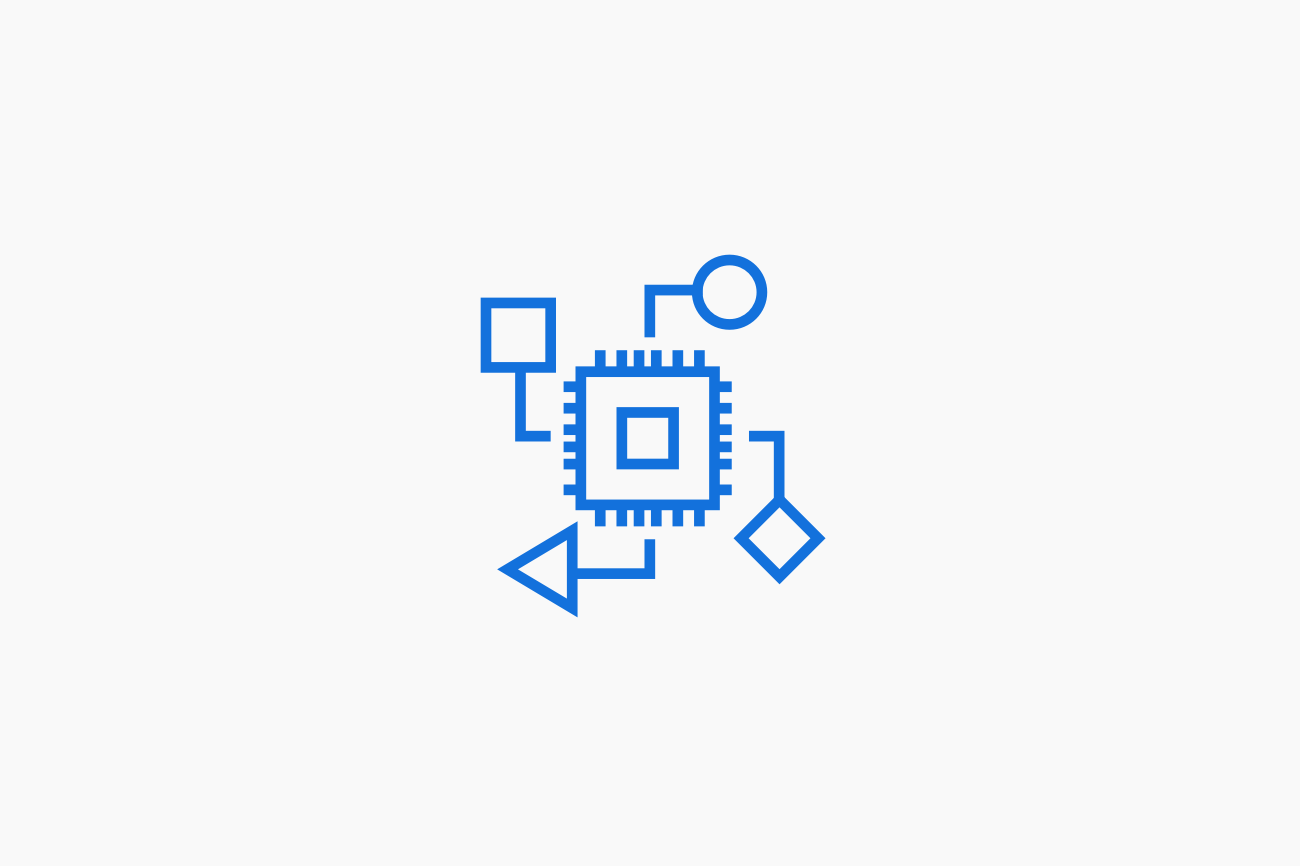
Reliability
Where we help, connected and autonomous vehicles, robotics and automation.
Medical Devices
Medical Device Operating System
Real-time os for rail systems.
Heavy Machinery
Operating System for Heavy Machinery
Industrial Controls
Real-Time OS for Industrial Control Systems
Aerospace and Defense
Embedded OS for Aerospace and Defense
Commercial Vehicles
Software for Commercial Vehicles

- Upcoming Events
Embedded World 2024, Nuremberg, Germany, April 9 — 11
Robotics Summit & Expo, Boston, MA, May 1 — 2, 2024
Automate 2024, Chicago, IL, May 6 — 9, 2024
AEK - Automobil Elektronik Kongress, Ludwigsburg, Germany, June 18 — 19, 2024
Event, Embedded
Event, Automotive
Search code, repositories, users, issues, pull requests...
Provide feedback.
We read every piece of feedback, and take your input very seriously.
Saved searches
Use saved searches to filter your results more quickly.
To see all available qualifiers, see our documentation .
- Notifications
Voyager is a fast, lightweight and open-source web application framework that provides you foundation to kick-start your web development.
voyager-php/voyager
Folders and files, repository files navigation, voyager framework.
- Routing Engine
- Middlewares and Security
- Caching System
- Form Validation
- Localization
- Templating Engine
- Database API
- Session and Cookie Management
- Authentication System
- Built-in CSS Utility
Installation
- Create new project by using the "composer create-project jameslevi/voyager ." command and wait for composer to download and install your fresh voyager framework project.
- Using your terminal, run the atmos command "php atmos --init" to generate your .env file and API key for your project.
- Serve your project using the "php atmos serve:80" command to start PHP built-in server in localhost at port 80.
- Run the command "php atmos project:debug" to start your development.
Security Vulnerabilities
If you discover some security issues or bugs that can cause security vulnerabilities, please email James Crisostomo via [email protected] .
This framework is an open-sourced software licensed under MIT License.
Releases 11
- JavaScript 1.5%
- Configuring the Voice Browser service
The Voice Browser service interprets VoiceXML content.
- Basic service settings
The General tab sets the basic service configuration.
For example:

- Setting package-level diagnostic logging
Note: Use this feature when instructed by Nuance Technical Support to investigate a problem that requires more detail in the log file.
You can use the Diagnostic Logging section on the General tab to fine-tune the logging levels of different code components in the Voice Browser service Java package. You can specify different levels at the package, subpackage, class, and method levels.
Enter the fully qualified name under the Package column and choose a logging level (ERROR, WARN, STATUS, D_INFO). To add another entry, click Add and enter the name and logging level. To remove an entry select it and click Remove.
The syntax for specifying different components is:
- Package—package.*, for example, nuance.*, nuance.voyager.*, and nuance.voyager.browser.*
- Class—package.class, for example, nuance.voyager.browser.Main
- Inner class—package.class$inner_class, for example, nuance.voyager.browser.Main$inner_class
- Method—package.class:method, for example, nuance.voyager.browser.Main:main
Inheritance rules apply—child components inherit their logging level from the parent component. For example, if you set a level at the class level, then all methods in that class inherit the same level. But once you set a level explicitly on a child, it no longer inherits the level from its parent. Inner or nested classes do not inherit logging levels from the parent class. You must explicitly set these.
The service applies logging levels from top to bottom. Be aware that entries added later might override entries added earlier. In the following example:
- The service level is WARN. Any package not specified in the Package region inherits this level.
- The first package sets the nuance.voyager.* package (and its subpackages) to STATUS.
- The next package sets the nuance.* (and its subpackages) to ERROR. Since the nuance.* package is a parent to nuance.voyager.*, it overrides the STATUS level.
- The last entry sets nuance.voyager.browser.Main class to DETAIL.
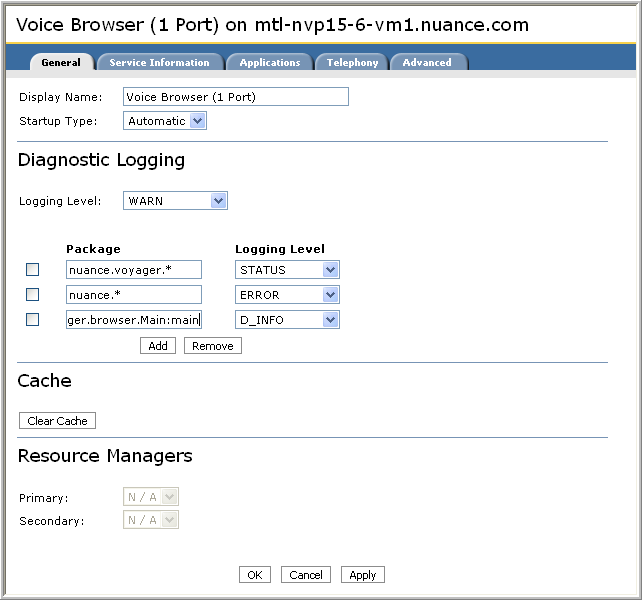
- Specifying VoiceXML applications
Use the Applications tab to specify the VoiceXML applications that the Voice Browser service executes for answering calls. (You must publish the applications before specifying them. See Deploying an application .)
The first row specifies the default application. Click Add to insert new rows for each additional application.
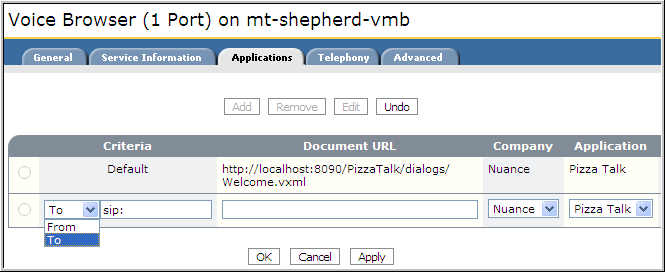
Depending on the criteria you specify, the service executes the same application for all calls (default) or routes calls to other applications based on the number dialed or the caller’s number (the To: and From: criteria). For example:
The general syntax of the Default Criteria is:
sip: myDNIS or ANI @ hostname [: port ]
The exact syntax depends on the telephony type (SIP or NMS), and there are differences for calls on a real network (PBX, gateway, SIP proxy) versus calls on a SIP softphone. For example, if the call goes through a real network, the DNIS or ANI is a phone number. With a SIP softphone, this value could be a phone number, the name of an application, or nvp.
In a real network, the port is determined by your PBX, gateway, or proxy. With a SIP softphone, you can optionally specify a port. The default port is 5060 on the first voice browser service instance, 5070 for the second, 5080 for the third, and so on. (The ports are configured in the role files.)
See the use cases below for more information. Here is a summary of the syntax:
The Voice Browser service implements this routing behavior as follows:
- Evaluate the To criteria
- Evaluate the From criteria
- Use the default application
http://app_srvr_host:port/app/dialogs/main.vxml
- app_srvr_host is the name or IP address of the host serving the application.
- port depends on the application server. It is always 8090 for the NVP application container service.
- app/dialogs/main.vxml is the path to the initial page of your application.
This example points to a travel application published on the application server host, mt-saturn: http://mt-saturn:80/MyTravelApp/dialogs/main.vxml
- Company and Application: Choose a value from the list or choose Other... to type your own company and application values. The values will be used to segregate call log files and utterances stored locally (on the host). Note that these values take precedence over that company_name and application_name values set in session.xml. See Developing Applications for Nuance Voice Platform for more information about session.xml.
- Use Session.xml: Check to specify a session.xml file for the particular application. Once checked, a text box appears for entering the pathname of the file. See Specifying a session.xml file for more information.
Restart the voice browser service to have the changes take effect.
- Changing the default application
This example changes the default sample application from PizzaTalk to a published travel application at http://mt-appsrv1:80/TravelTalk/dialogs/welcome.vxml.
- Display the voice browser service Application tab at the desired scope: network, host, or service instance. See Scope for more information.
- Select the default application row and click Edit.
- For Document URL, enter http://mt-appsrv1:80/TravelTalk/dialogs/welcome.vxml.
- For Company, choose Other... and enter the company name, for example, Frantic Tours.
- For Application, choose Other... and enter the application name, for example, TravelApp.
When finished, the Applications tab might look like this:

- Setting the To criteria
In this example, an application server host is running two applications for the Gizmos company, and you want to route callers dialing (777) 777-7777 to Customer Support and callers dialing (888) 888-8888 to Sales Support.
The To criteria must match exactly what is set in the incoming SIP INVITE. You can determine this from the gateway (or proxy) configuration but it’s easier to place a test call and examine the Voice Browser service logs to get this information. If the logging level is STATUS (default), search the log for “Answered call” to find the relevant information. (Alternatively, change the level to VD_INFO and search for the session.connection.localuri variable.) Example:
- Keep the logging level at STATUS.
- Let’s say that the call goes through a phone network to a gateway, which then sends an INVITE to NVP at mtl-nvp15-1-vm8. The gateway is configured to call NVP at that host’s IP address. Place a test call through the network taking the same path used by the caller.
LOG,STATUS,...Answered call from sip:[email protected] to sip:[email protected] on device9.>>>1.0>>>[email protected]>>>sip:[email protected]>>>9...
The log shows that NVP runs on host 10.2.22.222. You now have the information to configure the voice browser service.
Display the Applications tab for the Voice Browser service at the desired scope and specify the To fields. When finished, the tab might look like this:
- Setting To/From for a SIP softphone
In a development environment, you test applications with a SIP softphone. To get the URIs for the To and From values, place a test call to NVP and search the diagnostic logs for “Answered call”.
In this example, an SJPhone is installed on host 10.4.44.4 and NVP is installed on host 103.33.3.
For SJPhone, specify the the ANI (caller ID) in the From criteria as Anonymous . (Do this because the SIP softphone doesn’t send a caller ID as part of the URI string.)
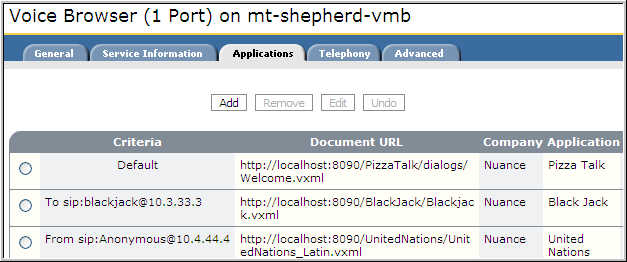
The URL you dial must match the specified criteria exactly. The results are:
- If you place a call to sip:[email protected], you get the Black Jack application.
- And if you place a call from sip:[email protected], you get the United Nations application.
- If you place a call to sip:[email protected], you get the PizzaTalk application. Since the To header in the SIP INVITE didn’t match either the To criteria, the default application is executed in this example.
- Specifying a session.xml file
The session.xml is an optional configuration file where you can specify parameter defaults and resources to load for a specific application. For details about these configurations, see Application defaults .
You can specify a session.xml file at the network, cluster, host, or service scope. For example, you might define three session.xml files for three applications at the network scope. Any host subsequently added to the network inherits the settings.
Note: These examples show the NVP application container service, which uses port 8090. In a typical deployment, you’d publish the applications on a third-party application server host and use a valid port number.
To specify a session.xml for individual applications:
- Display the Applications tab for the voice browser service.
To specify a session.xml file on an application already added, select the row and click Edit to enable the Use Session.xml field.
- Enter the pathname for the session.xml file. You can specify a file:// or http:// URL. For example:
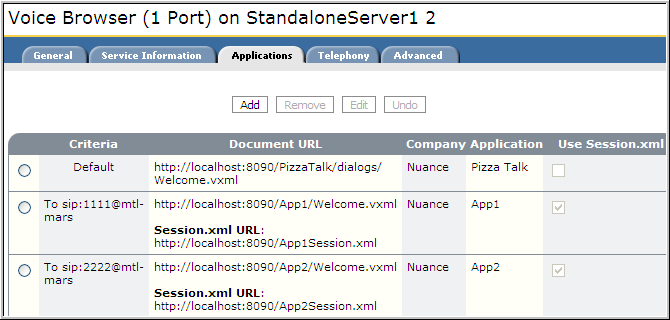
The Advanced tab shows how these settings are passed internally to the Voice Browser service :

If the Voice Browser service can’t fetch the session.xml, it rejects the call and generates an alarm. This might happen if the service can’t find the file at the specified URL or if the file is invalid.
To change or remove a session.xml file:
- Select the application and click Edit .
- Modify the Session.xml URL field to point to a different session.xml.
- Uncheck the Use Session.XML field to remove the session.xml file.
- Specifying a dial plan
Nuance recommends using the dial plan as much as possible. This allows your VoiceXML applications to be independent of the telephony configurations where they are deployed.
Use the Telephony tab to specify a dial plan. The dial plan transforms the URIs specified in VoiceXML applications and transforms them into valid telephone numbers that can be dialed from where NVP is running.
In the application, specify the URIs as part of the destination string of a call transfer. Examples:
In Management Station , use the Telephony tab to specify the Dial Plan:
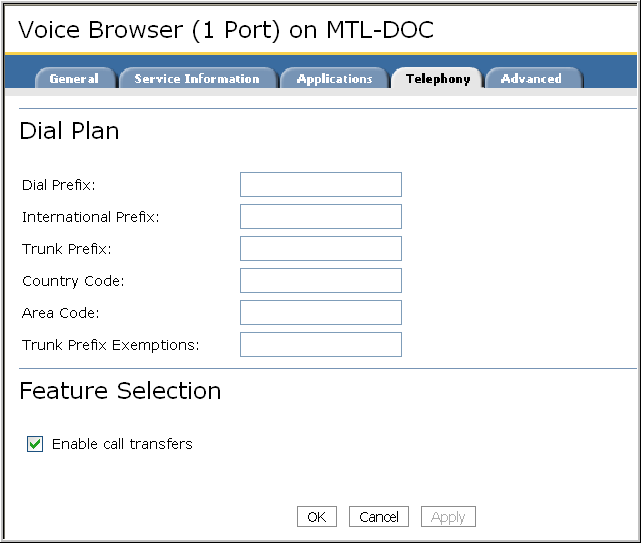
When the application specifies an absolute URI, the Voice Browser service extracts the phone number, removes the + sign, and compares the remaining number against the settings in the dial plan. Depending on any matches, it removes parts of the number and adds different prefixes to dial the call. The flow looks like this:
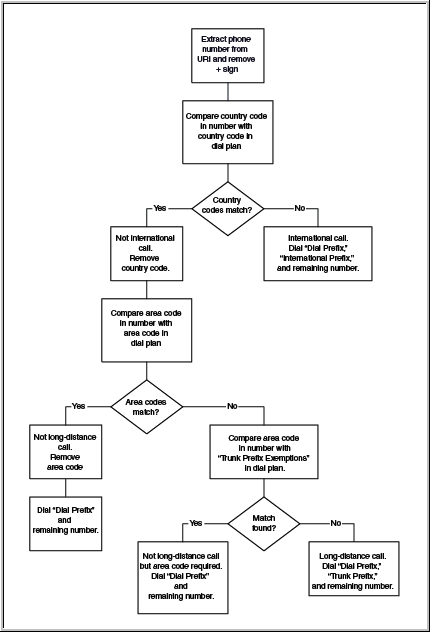
Here are two use case to illustrate how this works. The application specifies these absolute URIs:
+17817918650—Nuance office in Burlington, MA, U.S.
+15149047800—Nuance office in Montreal, QC, Canada
+441483794444—Nuance office in London, U.K.
- Example North America dial plan
For this example, assume the Voice Browser service is running in Burlington, MA. The dial plan might look like this:
The service transforms each URI into a valid telephone number based on the dial plan:
- Example Europe dial plan
For this example, assume the Voice Browser service is running in London, U.K. The dial plan might look like this:
This table shows the results:
- Setting advanced service properties
The Advanced tab displays the current service property settings. For example:
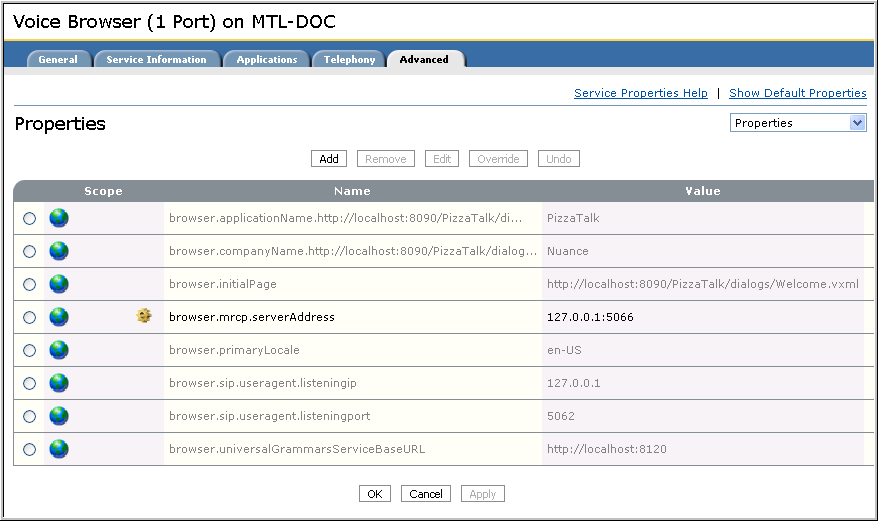
Optional. Use the Advanced tab to specify additional service properties. (The default values are appropriate for most scenarios and there is no need to configure non-default values.
- Related topics
© 2023 Nuance Communications, Inc. All rights reserved. Portions © 2024 Microsoft. All rights reserved. | Notice | Site map | Last Update: 2/22/2024

Voyager Browser
This technote describes how to configure the Voyager browser; for information on starting it, see voyager in the QNX 6 Utilities Reference .
To configure Voyager Browser, choose Preferences from the Edit menu. Voyager displays the WWW Configuration dialog:

WWW Configuration dialog
This dialog includes the following tabs:
Connection tab
Information tab.
The Cache Verify Policy options are:
The other cache tab options include:
Screen Rant
Voyager is why star trek is replacing discovery’s spore drive.
Starfleet is abandoning the spore drive in Star Trek: Discovery season 5, having found a better form of warp travel thanks to the USS Voyager.
WARNING: Contains SPOILERS for Star Trek: Discovery season 5, episode 1, "Red Directive"
- Star Trek: Discovery Season 5 bids farewell to the spore drive, as USS Voyager's pathway drive takes over in the 32nd century.
- Commander Stamets reveals Starfleet's decision to halt spore drive development, making Discovery unique in the Star Trek franchise.
- The USS Voyager-J's pathway drive paves the way for safer and sustainable warp travel in Star Trek's future.
The 32nd century's version of the USS Voyager is the reason that Star Trek: Discovery season 5 is abandoning Starfleet's revolutionary spore drive technology. Since they arrived in the 32nd century in season 3, the USS Discovery crew's one-of-a-kind spore drive has represented a potential replacement for dilithium-reliant warp travel in Star Trek 's future . However, various obstacles, most notably rogue Risan scientist Dr. Ruon Tarka (Shawn Doyle) and his theft of the only working prototype have prevented the spore drive from being rolled out.
In Star Trek: Discovery season 5, episode 1 , "Red Directive", Commander Paul Stamets (Anthony Rapp) reveals that Starfleet has shuttered further development on the spore drive . Starfleet's decision means that the USS Discovery will remain one-of-a-kind, making season 5 the last outing for Starfleet's spore drive. Instead of taking Discovery's spore drive further, Starfleet are instead forging ahead with the new pathway drive, first trialed by the USS Voyager-J in Star Trek: Discovery season 4 .
Star Trek Is Ditching Discovery's Spore Drive - And That's Good!
Uss voyager is why star trek is quitting discovery’s spore drive, voyager has a history of scientific advancement in starfleet..
In Star Trek: Discovery 's season 4 premiere, "Kobayashi Maru", it was revealed that the USS Voyager-J had been newly fitted with a protoype pathway drive . Federation President Laira Rillak (Chelah Horsdal) was looking for the right captain to command the ship and test out this new technology. Now, Discovery 's season 5 premiere, "Red Directive" reveals that those tests were successful, leading to the pathway drive being the new standard for future Starfleet ships. The rollout is still in the early stages, however, as Captain Rayner (Callum Keith Rennie) states that his ship, the USS Antares, doesn't have a pathway drive fitted.
Captain Michael Burnham (Sonequa Martin-Green) was under consideration to command the USS Voyager-J, but President Rillak didn't believe that she was ready.
It feels appropriate that the USS Voyager is responsible for replacing Star Trek: Discovery 's spore drive, given its namesake's impact on warp travel centuries earlier . Star Trek: Prodigy revealed that, after returning to the Alpha Quadrant, much of the technology the USS Voyager encountered in the Delta Quadrant was adapted by Starfleet. For example, the USS Dauntless, commanded by Vice Admiral Kathryn Janeway (Kate Mulgrew) had a quantum slipstream drive fitted, first encountered in Star Trek: Voyager 's season 4 finale, "Hope and Fear".
10 Ways USS Voyager Changed In Star Trek’s Delta Quadrant
When will we see star trek: discovery's pathway drive in action.
As the USS Discovery is in the middle of a vitally important mission to find the Progenitors' technology to create life, it doesn't seem like there will be much time for a refit. Therefore, it's unlikely that Discovery will be using the pathway drive at any point in Star Trek: Discovery season 5. It's certainly possible that Captain Burnham could receive assistance from a starship like the USS Voyager-J at some later point in Discovery season 5, but it's also possible that the pathway drive was just a tease of things to come in the now- canceled Star Trek: Discovery season 6 .
As it will focus on a batch of new recruits, the Starfleet Academy show feels like an ideal way to reveal more about the pathway drive.
Star Trek: Starfleet Academy will pick up the baton in the 32nd century, however, making it the most likely candidate for a pathway drive demonstration . As it will focus on a batch of new recruits, the Starfleet Academy show feels like an ideal way to reveal more about the pathway drive. As the cadets learn how a pathway drive works, and how it differs from a more traditional warp drive, so too will Star Trek fans who tune into the YA-oriented show. Starfleet Academy leading the way with a new warp drive replacement would be a fitting way to continue the legacy of Star Trek: Discovery and its spore drive.
Star Trek: Starfleet Academy is looking to begin production in late summer 2024.
Star Trek: Starfleet Academy
After being closed for over a hundred years, Starfleet Academy is reopening its doors to those who wish to pursue a career as Starfleet Officers. Star Trek: Starfleet Academy will follow a new group of cadets as they come of age, and build friendships, rivalries, and romantic relationships while being threatened by a new adversary that could destroy the Academy and the Federation itself.
Why Star Trek Keeping Standard Warp Travel Is Best
The specifics of how the pathway drive works are still a mystery in Star Trek: Discovery season 5, but it's presumably rooted in traditional warp travel. The spore drive was an incredibly complicated method of travel that required specific calculations and a willing host to navigate the mycelial network . In "Red Directive", Stamets states that, with more time, he could have worked out the issues with navigation, but never got the chance. The grisly fate of the USS Glenn in Discovery season 1 revealed that the slightest miscalculation in spore drive navigation could have devastating consequences for the crew.
Presumably, the pathway drive is a means to achieve warp travel while using less dilithium, to reduce the Federation's reliance on it following the scarcity caused by the Burn. This is therefore a less risky proposition, which will be why Starfleet are now rolling it out following the USS Voyager-J's successful trial. While it may be disappointing for Stamets in Star Trek: Discovery , the pathway drive's potential to make warp travel safer and more sustainable should be something to celebrate.
Star Trek: Discovery streams Thursdays on Paramount+.
Star Trek: Prodigy season 1 is streaming on Netflix.
Star Trek: Discovery
*Availability in US
Not available
Star Trek: Discovery is an entry in the legendary Sci-Fi franchise, set ten years before the original Star Trek series events. The show centers around Commander Michael Burnham, assigned to the USS Discovery, where the crew attempts to prevent a Klingon war while traveling through the vast reaches of space.
Star Trek Voyager
The fifth entry in the Star Trek franchise, Star Trek: Voyager, is a sci-fi series that sees the crew of the USS Voyager on a long journey back to their home after finding themselves stranded at the far ends of the Milky Way Galaxy. Led by Captain Kathryn Janeway, the series follows the crew as they embark through truly uncharted areas of space, with new species, friends, foes, and mysteries to solve as they wrestle with the politics of a crew in a situation they've never faced before.
Star Trek: Prodigy
Star Trek: Prodigy is the first TV series in the Star Trek franchise marketed toward children, and one of the few animated series in the franchise. The story follows a group of young aliens who find a stolen Starfleet ship and use it to escape from the Tars Lamora prison colony where they are all held captive. Working together with the help of a holographic Captain Kathryn Janeway (Kate Mulgrew), the new crew of the USS Protostar must find their way back to the Alpha Quadrant to warn the Federation of the deadly threat that is pursuing them.

IMAGES
VIDEO
COMMENTS
Voyager is a discontinued web browser for the Amiga range of computers, developed by VaporWare. Voyager supports HTML 3.2 and some HTML 4, JavaScript, frames, SSL, Flash, and various other Internet Explorer and Netscape Navigator features.
Platform operating system designed for the Internet of Things. Download Voyager for free. I present to you Voyager 23.10 non LTS and 22.04 LTS Edition Explorer in final version. A 2-in-1 version with, for the first time, the Gnome and Xfce desktops unified in a single Voyager distribution, to be selected during your session.
I present to you Voyager 23.10 non LTS and 22.04 LTS Edition Explorer in final version. A 2-in-1 version with, for the first time, the Gnome and…
In this paper, we seek to complement manual chart construction with interactive navigation of a gallery of automatically-generated visualizations. We contribute Voyager, a mixed-initiative system that supports faceted browsing of recommended charts chosen according to statistical and perceptual measures. We describe Voyager's architecture ...
Voyager: Compose on Warp Speed. A multiplatform navigation library built for, and seamlessly integrated with, Jetpack Compose. Create scalable Single-Activity apps powered by a pragmatic API: class HomeScreenModel : ScreenModel {.
Voyager. I co-developed Voyager together with Oliver Wagner who started it in 1995. This is a fully featured browser for AmigaOS supporting plenty of web "standards". There was also a version for an embedded system (CaOS) and it was also bundled with MorphOS. It runs on 68k, coldfire and PPC.
The main web-browsing agent consists of four sub-agents: CurriculumAgent: Proposes what task the main Voyager agent should attempt next, drawing from a dynamic task pool.-; ActionAgent: Generates executable code as actions based on the given task and previous execution feedback.This is the agent that interacts with web elements like buttons, forms, and navigational elements.
Voyager 2 is a data exploration tool that blends manual and automated chart specification. Voyager 2 combines PoleStar, a traditional chart specification tool inspired by Tableau and Polaris (research project that led to the birth of Tableau), with two partial chart specification interfaces: (1) wildcards let users specify multiple charts in parallel,(2) related views suggest visualizations ...
Voyager automates workflows and provides system-wide transparency that enables you to work more productively and collaboratively than ever before. Using any browser and mobile device, Voyager gives you instant access to your data. And as a SaaS platform, Voyager frees you from managing your software — so you can focus on your business.
Originally created as a research project by Jeff Heer's Interactive Data Lab (IDL) at the University of Washington, with implementation led by Kanit Wongsuphasawat and Dominik Moritz, Voyager is a visualization browser for exploring the breadth of datasets with ease through automated visualization recommendations.In collaboration with IDL, the Bocoup Data Visualization team helped make ...
Harness AI-enabled insights that seamlessly integrate with 3D scanners and Neptune, maximizing the potential of your scan data. Voyager helps Eaton streamline product development and production across international business units through one collaborative software platform to share, review, and edit scans in real time.
Lumafield Voyager is a powerful AI-enabled, cloud-based software platform for viewing, analyzing, and sharing 3D scans and industrial CT scans. In this video, Lumafield Co-Founder and Head of Product Andreas Bastian introduces Voyager and its AI co-pilot Atlas.. Voyager and Atlas make it easy to inspect parts, compare parts to their original CAD models, take dimensions, and share data with ...
I, Voyager is a free, open-source software planetarium designed for game and educational software development. It features the real, dynamic orbits of planets, moons and asteroids — with much more to come! I built I, Voyager to be improved, modified and extended by the community.
Welcome to Voyager Browser. This web browser is a QNX-enhanced version of the Spyglass browser. You can run Voyager in two modes: compact and full. You may find it useful to run Voyager in compact mode when memory is tight. Compact mode. Some of the features Voyager supports in compact mode include:
Then, scroll down to find the column you want to include. If you want the column, in this instance (ID), to be shown in header, check the box for browse in visibility. If you don't want, just uncheck it. The same goes for other columns. After you are done, scroll down to the bottom of the page and click submit.
Chrome maintains its longtime lead on this test with a score of 528. Edge, Opera, and other Chromium-based browsers hew closely to Chrome. Firefox and Safari bring up the rear, at 515 and 468 ...
Version 2.02: Bookset overview; User's Guide. This guide tells you how to: set up a connection to the Internet configure and run Voyager Browser and Voyager Email
Windows 10 is supported for Voyager 9.2.1 (in General Release as of 07 June 2016) and higher. "Supported versions" for a particular Windows operating system are those versions of Voyager that have been tested on that specific version of Windows. Voyager may run on a Windows version for which it is not explicitly supported; but until Ex Libris ...
Create new project by using the "composer create-project jameslevi/voyager ." command and wait for composer to download and install your fresh voyager framework project. Using your terminal, run the atmos command "php atmos --init" to generate your .env file and API key for your project.
Since the nuance.* package is a parent to nuance.voyager.*, it overrides the STATUS level. The last entry sets nuance.voyager.browser.Main class to DETAIL. Specifying VoiceXML applications. Use the Applications tab to specify the VoiceXML applications that the Voice Browser service executes for answering calls. (You must publish the ...
Voyager Help Information Browser Installation 54504301 Rev. - This document supports Voyager Help Information Browser Version 4.x and higher. 6. When installing from the Voyager Help Information Browser DVD, do the following. a. Open Windows Explorer, and navigate to: D:\VoyagerSetup.exe (where D:\ is the drive letter of the optical disc drive) b.
Voyager always downloads the web page from the Internet. Once per session: During a session, Voyager will check once to see if a web page on the Internet has been updated. Voyager does not update the files on your network (e.g. you typed file in the Site input field instead of http). If a file has been changed, click on Reload to see the ...
Well within the last two years, three major Amiga-native browsers (as opposed to AMosaic, which was a port of the original Mosaic) have been developed and introduced. IBrowse, Voyager, and AWeb have all brought significant improvements over AMosaic, and make almost any Amiga with a hard disk and some extra memory fully Web-capable.
It feels appropriate that the USS Voyager is responsible for replacing Star Trek: Discovery's spore drive, given its namesake's impact on warp travel centuries earlier.Star Trek: Prodigy revealed that, after returning to the Alpha Quadrant, much of the technology the USS Voyager encountered in the Delta Quadrant was adapted by Starfleet.For example, the USS Dauntless, commanded by Vice Admiral ...